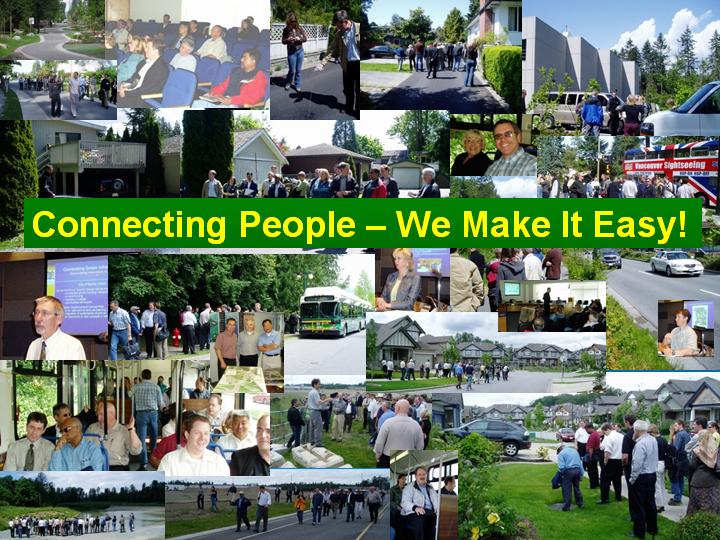Regional District of Nanaimo and City of Nanaimo co-host first in ‘2007 Showcasing Innovation Series’
‘Design with Nature’ is the event theme for celebrating Green Infrastructure
The CAVI-Convening for Action on Vancouver Island Partnership has announced that the Regional District of Nanaimo and the City of Nanaimo will co-host the first event in a series of three events that comprise Showcasing Green Infrastructure Innovation on Vancouver Island: The 2007 Series. The Nanaimo event will be on Friday, September 14. For more information on the series, please click here.
 According to John Finnie, Chair of the CAVI Leadership Team, “The Regional District of Nanaimo and City of Nanaimo will showcase their over-arching ‘green development’ policies and how they are being implemented on the ground. The combination of presentations in the morning and a tour of project sites in the afternoon will provide some insight into strengths and limitations in trying to develop in a more sustainable manner.”
According to John Finnie, Chair of the CAVI Leadership Team, “The Regional District of Nanaimo and City of Nanaimo will showcase their over-arching ‘green development’ policies and how they are being implemented on the ground. The combination of presentations in the morning and a tour of project sites in the afternoon will provide some insight into strengths and limitations in trying to develop in a more sustainable manner.”
“The Nanaimo Showcasing focus will be on three policies that each address public concerns on different scales”, adds Rob Lawrance, Presentation Team Leader for the City of Nanaimo, “Each policy and application represents a ‘first’ for either the region or the City of Nanaimo.”
Scope of Nanaimo Program
On September 14, there will be reporting out on a regional Climate Change adaptation policy, a Steep Slope subdivision development policy, and a Green ‘Sustainable’ building construction policy for City buildings. For program and registration details, please click on this link to download Showcasing Green Infrastructure Innovation in the Nanaimo Region.
 “From a City of Nanaimo perspective, the Showcasing Innovation Series is timely”, notes Rob Lawrance, “Our participation has served as a catalyst for the City to evaluate our progress to date and reflect on lessons learned from our experience. The City is enthusiastic about sharing what we have learned with our peers in other Vancouver Island municipalities.
“From a City of Nanaimo perspective, the Showcasing Innovation Series is timely”, notes Rob Lawrance, “Our participation has served as a catalyst for the City to evaluate our progress to date and reflect on lessons learned from our experience. The City is enthusiastic about sharing what we have learned with our peers in other Vancouver Island municipalities.
 The Water Sustainability Action Plan for British Columbia is the umbrella for the Showcasing Innovation Series. According to Kim Stephens, Program Coordinator for the Action Plan, “It is exciting to see how local governments are responding to the Showcasing Innovation Series. This program enables local governments to tell their stories in a way that no other forum provides.” Stephens will be the Moderator for the morning session.
The Water Sustainability Action Plan for British Columbia is the umbrella for the Showcasing Innovation Series. According to Kim Stephens, Program Coordinator for the Action Plan, “It is exciting to see how local governments are responding to the Showcasing Innovation Series. This program enables local governments to tell their stories in a way that no other forum provides.” Stephens will be the Moderator for the morning session.
In the City, the site tour in the afternoon will feature Cottle Creek Estates (Steep Slope Development), the Oliver Road Community Centre (LEED Silver Green Building), and the ‘Inland Kenworth’ site on Northfield Road.
 In the Regional District, the tour will feature the Fairwinds Green Solutions Demonstration Home, a rainwater infiltration pond at the RDN offices, and creek channel day-lighting at the Greater Nanaimo wastewater treatment plant on Hammond Bay Road.
In the Regional District, the tour will feature the Fairwinds Green Solutions Demonstration Home, a rainwater infiltration pond at the RDN offices, and creek channel day-lighting at the Greater Nanaimo wastewater treatment plant on Hammond Bay Road.
Showcasing Innovation Builds Capacity
The purpose of the Showcasing Innovation Series is to celebrate… and build on…the on-the-ground successes that are enhancing the ways communities are being developed and water is being managed.
“Practitioners in local government do want to learn from those who are innovating, and they do want to visit projects that are precedent-setting,” observes John Finnie, “They just need a starting point and a push to get the ball rolling.”
The goal is to promote networking, build regional capacity, and move ‘from awareness to action’ — through sharing of green infrastructure approaches, tools, experiences and lessons learned as an outcome of designing with nature, according to Kim Stephens.
Oliver Road Community Centre: A LEED Silver Green Building
The City’s Green Building Policy requires all new public buildings over 500 square metres to meet the LEED Silver standard. This is part and parcel of the City’s commitment to develop climate change and energy plans under the aegis of the Partners for Climate Change Program.
Rob Lawrance and Maurice Mauch will co-present in order to provide the planning and construction perspectives, respectively, for the Oliver Road Community Centre.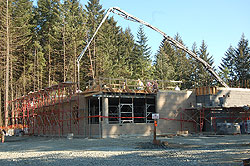
Consistent with the objectives of the regional and City climate change adaptation plans, this project will provide improved energy performance systems, water conservation features, and alternatives to automobile transportation such as proximity to transit and indoor bike racks.
“Because the Oliver Road Community Centre is the first City project to follow the LEED approach, it has been a learning experience, with the lessons learned being transferable to other communities that are considering LEED policies”, notes Rob Lawrance.
“Having an integrated design and construction team proved invaluable”, adds Maurice Mauch, “This approach enabled timely and effective resolution of unforeseen challenges. The team came up with a number of innovative solutions on site, which would not have happened with a traditional approach to project implementation.”
A noteworthy aspect of site development is the way trees have been retained and rainwater capture features are being incorporated.
Rainwater Capture at ‘Inland Kenworth’ Industrial Site
Completed in 2006, this award-winning project applied a unique approach to site development that combined function and design in first capturing and then absorbing rainwater on-site. The project won a City environmental award and is currently a candidate for a design award.
Gary Noble and Dean Mousseau will co-present the Inland Kenworth story in order to provide the planning and construction perspectives, respectively.
 According to Gary Noble, a planner with the City of Nanaimo, “This is an outstanding example of an innovative and collaborative approach to achieve a ‘design with nature’ outcome on an industrial site. We asked the project development team to recognize the coal mining heritage of the area, retain the existing tree buffer, and be creative. They achieved all three!”
According to Gary Noble, a planner with the City of Nanaimo, “This is an outstanding example of an innovative and collaborative approach to achieve a ‘design with nature’ outcome on an industrial site. We asked the project development team to recognize the coal mining heritage of the area, retain the existing tree buffer, and be creative. They achieved all three!”
Consistent with the heritage theme, roof drainage is conveyed via a sluice box structure that discharges onto a rock garden.

An adjacent wetland on the east side of the site receives rainwater runoff from the building roof and parking lot. The parking lot includes swale filters around its perimeter.
“The building was re-sited to preserve the tree buffer,” explains Noble, “Also, the offices have a view of the trees. This results in a pleasing work environment.”
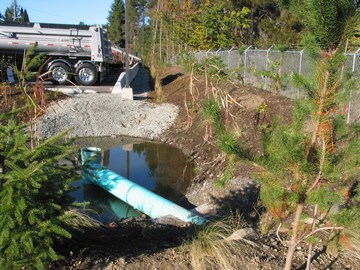
Cottle Creek Estates: First Application of Steep Slope Policy
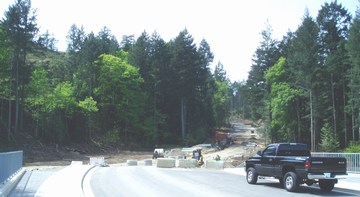
Pressure to build on hillside lands was the catalyst for adopting the City’s steep slope development permit area and zoning bylaws. Cottle Creek Estates provides an early example of how these bylaws, and Nanaimo’s approach to green infrastructure, are being implemented.
The vision of Cottle Creek Estates is one that brings people and nature together. Custom home designs will ensure that the homes are best suited to the view, sunlight, privacy and natural tock and tree locations of each lot.
Deborah Jensen and Kevin Brydges will co-present the City’s Cottle Creek experience in order to provide the planning and biological perspectives, respectively, for this precedent-setting residential development off Hammond Bay Road in the Departure Bay area of Nanaimo.
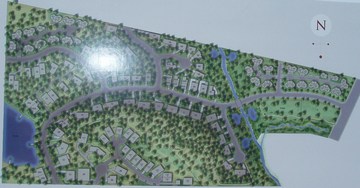
Guiding principles included altering standard development practices, clustering of houses, and working with the landscape. According to Deborah Jensen, “It was exciting to collaborate with the Cottle Estates developer to fit houses into the natural environment through application of design with nature principles.”
 Preservation of the forested setting ultimately relies on the combination of restrictive covenants plus attracting property owners who embrace environmental stewardship. “The restrictive covenant for each property establishes a building envelope and requires that the surrounding area remain in a natural forested condition”, elaborates Jensen.
Preservation of the forested setting ultimately relies on the combination of restrictive covenants plus attracting property owners who embrace environmental stewardship. “The restrictive covenant for each property establishes a building envelope and requires that the surrounding area remain in a natural forested condition”, elaborates Jensen.
Consistent with the design with nature approach to development, the houses at the top of the ridge will be set back in the trees. “This means homeowners will still have a view while preserving a forested viewscape from below”, notes Jensen, “This contrasts with nearby subdivisions where all you see is a row of houses along the ridgeline.”
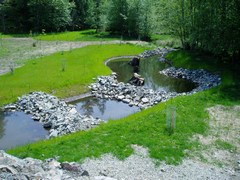 Cottle Creek Estates includes restoration of fish habitat through a former farm at the base of the hillside. According to Kevin Brydges, “The developer embraced the creek restoration project because he saw it as an amenity that would add green value to the development.” Flow in the creek is replenished by a system of swales and decorative ponds that have been incorporated in the hillside development.
Cottle Creek Estates includes restoration of fish habitat through a former farm at the base of the hillside. According to Kevin Brydges, “The developer embraced the creek restoration project because he saw it as an amenity that would add green value to the development.” Flow in the creek is replenished by a system of swales and decorative ponds that have been incorporated in the hillside development.
 Because it was the first application of the steep slope policy, the Cottle Creek project involved a considerable front-end investment by the developer to address technical issues identified through the collaborative process. “Once the Development Permit process was completed, all our questions had been answered and any issues had been resolved. Now the developer can get on with implementation to demonstrate how working with nature results in a superior outcome”, concludes Brydges.
Because it was the first application of the steep slope policy, the Cottle Creek project involved a considerable front-end investment by the developer to address technical issues identified through the collaborative process. “Once the Development Permit process was completed, all our questions had been answered and any issues had been resolved. Now the developer can get on with implementation to demonstrate how working with nature results in a superior outcome”, concludes Brydges.
Climate Change Adaptation: Community Action Plans Set a Direction
In 2002, the Regional District of Nanaimo and the City of Nanaimo joined the Partners for Climate Change Program. This innovative program to address climate change at the local level is led by the Federation of Canadian Municipalities (FCM) and the International Council for Local Environmental Initiatives-Local Governments for Sustainability.
Under the direction of the RDN Climate Change Select Committee, five individual plans (for the RDN, Nanaimo, Qualicum Beach, Parksville and Lantzville) plus one overall community plan are being developed to reduce corporate energy use and greenhouse gas emissions (GHG).
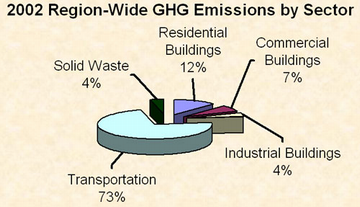
According to Carey McIver, RDN Project Manager, “The RDN and its member municipalities have voluntarily embraced developing climate change and energy plans for their respective operations and the region-wide community. These initiatives reflect an integrated approach to environmental protection and sustainability.”
McIver explains that these individual initiatives emphasize the linkages and coordination of regional and municipal services and the role of local governments in reducing GHG emissions through:
Land-use, energy and transportation planning
Infrastructure design
Purchase and use of sustainable products and services
Building retrofits
Water conservation
Solid waste diversion
Use of renewable energy
The overall objective is to reduce GHG emissions with the benefits of reducing the region’s impact on climate change, developing more sustainable communities, saving money, and preparing for a carbon trading future. For more information, click on Action for Climate Change.
What is Green Infrastructure?
To help advance a new way-of-thinking about land development, CAVI has developed and is promoting use of the following hierarchy of ‘green’ vocabulary:
- Green Value means land use strategies will accommodate settlement needs in practical ways while protecting the ecological resources upon which communities depend. At the heart of a Green Valueapproach is the valuation methodology that provides the business case for reconciliation of short-term versus long-term thinking related to risk and profit.
- Design with Nature is one approach to achieve Green Value, and is supportive of community goals that relate to building social capacity.

- Green Infrastructure is the on-the-ground application of Design with Nature standards and practices.
- Water Sustainability is achieved through Green Infrastructure practices that reflect a full and proper understanding of the relationship between land and water.
This cascading vocabulary was unveiled at the Creating Our Future Workshop that was held in conjunction with the Gaining Ground Summit in Victoria in June 2007. The Creating Our Future Workshop was a consultation opportunity for Vancouver Island local governments that are interested in implementing infrastructure practices and regulation that result in green value.
Green Infrastructure Explained
Green infrastructure is associated with the management of water that runs off the land and how water runoff impacts on the sustainability of both terrestrial and aquatic habitat and resources.
Green infrastructure is also associated with how water is used and how water use impacts on the sustainability of water supply.
 “Desired outcomes for water sustainability and green infrastructure can be achieved through infrastructure standards that reflect a full and proper understanding of the relationship between land and water”, explains Kim Stephens.
“Desired outcomes for water sustainability and green infrastructure can be achieved through infrastructure standards that reflect a full and proper understanding of the relationship between land and water”, explains Kim Stephens.
According to CAVI Chair John Finnie, “If we are to control our destiny and create our future, then we need to challenge our fellow Vancouver Islanders to visualize what they  want Vancouver Island to look like in 50 years. We have identified two desired outcomes in Convening for Action. First, we wish to influence Vancouver Island local governments to adopt Design with Nature as the preferred process of approving land development applications. Secondly, we intend to facilitate the move from awareness to action in changing the way that land is developed and water is used on Vancouver Island.”
want Vancouver Island to look like in 50 years. We have identified two desired outcomes in Convening for Action. First, we wish to influence Vancouver Island local governments to adopt Design with Nature as the preferred process of approving land development applications. Secondly, we intend to facilitate the move from awareness to action in changing the way that land is developed and water is used on Vancouver Island.”
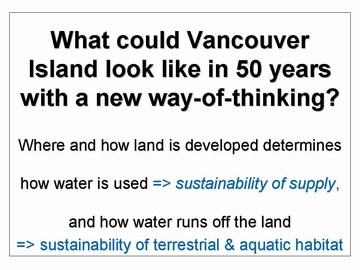
Posted August 2007



